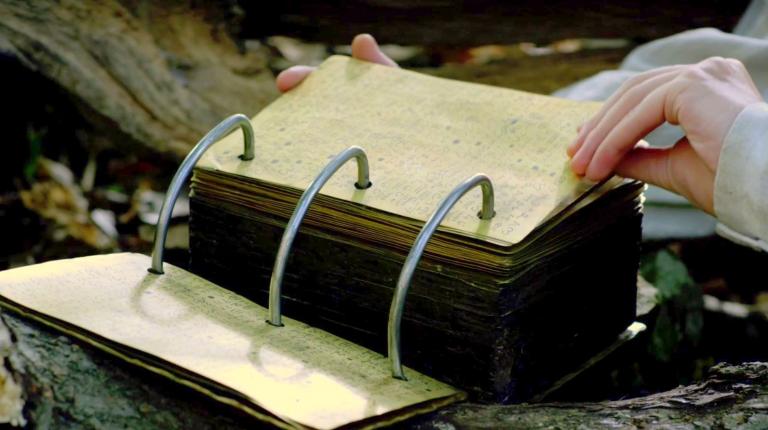
(still photograph by James Jordan)
Many years ago, a friend who was sympathetic to the Church but not a believer in the Book of Mormon asked me what the point of the golden plates was. After all, he said — he was quite well informed regarding Latter-day Saint beliefs — Joseph Smith apparently didn’t need them in order to translate and dictate the text. Sometimes, in fact, they weren’t even in the same room with him.
I recall responding to his question by answering that the plates were, in my opinion, at a minimum, an absolutely indigestible lump in the throats of people like himself. (We had a really good relationship, and I could say things like that to him without giving offense.)
Why would I say such a thing, apart from being naturally cheeky?
He wanted to believe that the Book of Mormon resulted from a purely subjective experience in the mind of Joseph Smith, that it was just a creation of Joseph’s own fertile imagination. But it seems clear to me that the plates decisively remove the Book of Mormon story from the realm of purely subjective experience. If they existed at all — and the evidence that they did exist is, in my judgment, absolutely conclusive — the plates were entirely real. Multiple witnesses saw them and even claimed to have “hefted” them. In fact, several of those who reported encounters with them estimated their weight at a quite tangible forty pounds or more.
Joseph Smith’s story dramatically differs, in this regard as in others, from that of the early-seventh-century Muslim prophet Muhammad, who had no corroborating witnesses to his production of the Qur’an. Indeed, strikingly, many if not most of Joseph’s revelations were shared with others.. By contrast, Muhammad’s claimed revelatory experiences were personal, individual, belonging to him and to him alone — and thus, in that sense at least, subjective.
To me, the plates force the question of the truth of the Book of Mormon in a much more direct and inescapable way than does the Qur’an. Somebody made them (to say nothing of the other strange material objects reported by Joseph’s contemporaries to have been in his possession, for at least a time).
Moreover, for what it’s worth, the palpable material reality of the plates probably served to reassure Joseph himself, in case he ever wondered about his sanity — as, accorded to the earliest Arabic sources, Muhammad definitely did. “I don’t blame any one for not believing my history,” Joseph once remarked. “If I had not experienced what I have, I would not have believed it myself.” In contrast to Joseph Smith, the Prophet of Islam lacked any fellow witnesses or material objects to confirm him in times of doubt.
Ah, but — say certain critics of the Restoration — even if the plates existed, their sheer existence doesn’t prove that they were ancient or that the Book of Mormon has any connection with the divine (if, indeed, the divine itself exists!). The mere existence of a set of metallic plates, in and of itself, neither demonstrates the validity of the Restoration nor illustrates its deep roots in antiquity.
True.
After all, we’re using a recently manufactured set of plates as a prop in our Witnesses film project. Why couldn’t Joseph have manufactured or obtained a recently-created set of plates for use as a prop to accompany the creation of his fake new religious text?
He could have, I suppose. Though that would have been much harder than some seem to assume. The plates that we’re using in our film project were created by an experienced professional metalworker, who (as he says in an interview that we filmed and that will likely figure in our documentary and accompanying materials) found the process quite demanding and difficult. Moreover, unlike our plates, Joseph’s were made of either gold or, more likely a gold alloy — rather unexpectedly on the American frontier and connected with a family of subsistence farmers. And, unlike our plates, they disappeared.
The existence of both the Book of Mormon plates and our prop plates requires explanation. As I said above, somebody made them. Thus, the sheer existence of the plates does make historical Nephites (slightly) more likely than the non-existence of the plates would, especially given the absence of any evidence that any particular nineteenth-century frontier American made them.
But we’re not talking about the mere existence of golden plates. Because we’re not talking merely about the Eight Witnesses to the Book of Mormon. Here is where the Three Witnesses come into play.
In their experience, they didn’t just see the plates, or even (unlike the Eight) just the plates and a few other mute physical objects. They saw an angel. And they heard the voice of God declaring that “they have been translated by the gift and power of God.” If accepted as authentic. their testimony argues very powerfully for divine involvement in the Book of Mormon and, accordingly, for the truth of the narrative and doctrine that it contains.
Neither the Eight Witnesses nor the Three Witnesses nor the additional or informal witnesses to the Book of Mormon stand alone. Together, though, they represent powerful evidence, forming a potent element of a cumulative overall case.
***

The newest new article in Interpreter: A Journal of Latter-day Saint Faith and Scholarship is by Matthew L. Bowen, of Brigham Young University’s campus in Laie, Oahu, Hawaii, and bears the title,
Abstract: Genesis 30:23–24 offers a double etiology for Joseph in terms of “taking away”/“gathering” (ʾāsap) and “adding” (yāsap). In addition to its later narratological use of the foregoing, the Joseph cycle (Genesis 37–50) evidences a third dimension of onomastic wordplay involving Joseph’s kĕtōnet passîm, an uncertain phrase traditionally translated “coat of many colours” (from LXX), but perhaps better translated, “coat of manifold pieces.” Moroni1, quoting from a longer version of the Joseph story from the brass plates, refers to “Joseph, whose coat was rent by his brethren into many pieces” (Alma 46:23). As a military and spiritual leader, Moroni1 twice uses Joseph’s torn coat and the remnant doctrine from Jacob’s prophecy regarding Joseph’s coat as a model for his covenant use of his own coat to “gather” (cf. ʾāsap) and rally faithful Nephites as “a remnant of the seed of Joseph” (Alma 46:12–28, 31; 62:4–6). In putting that coat on a “pole” or “standard” (Hebrew nēs — i.e., “ensign”) to “gather” a “remnant of the seed of Joseph” appears to make use of the Isaianic nēs-imagery of Isaiah 11:11–12 (and elsewhere), where the Joseph-connected verbs yāsap and ʾāsap serve as key terms. Moroni’s written-upon “standard” or “ensign” for “gathering” the “remnant of the seed of Joseph” constituted an important prophetic antetype for how Mormon and his son, Moroni2, perceived the function of their written record in the latter-days (see, e.g., 3 Nephi 5:23–26; Ether 13:1–13).











